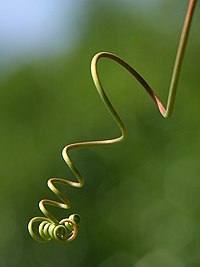Climbing plant



Climbing plants are plants which climb up trees and other tall objects. Many of them are vines or lianas. Their stems twine round trees and branches.
There are various ways of climbing. The climbing habit has evolved many times.[1] In most cases the climbing plants were more diverse (had more species) than their non–climbing sister groups.[2]
It is a key innovation which has been very successful.[3] Over 130 plant families include climbers.[4] Vine species may be more than 40% of species diversity in tropical forests.[5][6]
It has evolved independently in several plant families, using many different climbing methods:[7] Botanists generally divide climbing plants into two broad groups:
- Bines, which twine their stems around a support. Many bines have rough stems or downward-pointing bristles to aid their grip.[8][9]
- Hops (used in flavoring beer) are a commercially important bine.
- Morning glory, Ipomoea species.
- Honeysuckle
- Vines which use tendrils, suckers and other methods.
- twining petioles (e.g., Clematis species)
- using tendrils, which may be specialized shoots (Vitaceae), leaves (Bignoniaceae), or even inflorescences (Passiflora)
- using tendrils which have adhesive pads at the end. The pads attach themselves quite strongly to the support, (Parthenocissus: Virginia creeper)
- using thorns (e.g. climbing rose) or other hooked structures, such as hooked branches (e.g. Artabotrys hexapetalus)
- by clinging roots (e.g., ivy, Hedera species)
The climbing fetterbush (Pieris phillyreifolia) has a strange habit. It is a woody shrub vine which climbs without clinging roots, tendrils, or thorns. Its stem goes into a crack in the bark of fibrous barked trees (such as bald cypress). The stem flattens and grows up the tree underneath the host tree's outer bark. The fetterbush then sends out branches that emerge near the top of the tree.[10]
Most vines are flowering plants. These may be divided into woody vines or lianas, such as wisteria, kiwifruit, and common ivy, and herbaceous (nonwoody) vines, such as morning glory.
One odd group of climbing plants is the fern genus Lygodium, called "climbing ferns".[11] The stem does not climb, but rather the fronds (leaves) do. The fronds unroll from the tip, and theoretically never stop growing; they can form thickets as they unroll over other plants, rock faces, and fences.
Examples
[change | change source]
- Grape
- Honeysuckle
- Hydrangea
- Kudzu
- Luffa
- Lygodium
- Morning glory
- Nepenthes
- Passionfruit
- Poison ivy
- Solanum
- Sweet pea
- Virginia creeper
- Vitis
- Wild grape
- Wisteria
References
[change | change source]- ↑ Darwin, Charles 1880. The power of movement in plants. London: Murray.
- ↑ Gianoli, Ernesto 2004. Evolution of a climbing habit promotes diversification in flowering plants. Proc. R. Soc. Lond. B. 271 (1552) 2011-2015. [1]
- ↑ A "key innovation" is a trait which allows a clade to exploit a previously unused or under-used resource. Simpson G.G. 1953 The major features of evolution. New York: Columbia University Press.
- ↑ Gentry A.H. 1991 The distribution and evolution of climbing plants. In The biology of vines (eds F.E. Putz & H A. Mooney), pp. 3–49. Cambridge University Press.
- ↑ Schnitzer S.A. & Bongers F. 2002 The ecology of lianas and their role in forests. Trends Ecol. Evol. 17, 223–230.
- ↑ Phillips O.L. et al 2002. Increasing dominance of large lianas in Amazonian forests. Nature 418, 770–774.
- ↑ Francis E. Putz. "Vine ecology". Archived from the original on 2019-11-18. Retrieved 2012-03-01.
- ↑ bine at Merriam-Webster
- ↑ Cone heads at Willamette Week
- ↑ Alan Weakley Flora of the Southern and Mid-Atlantic States Archived 2018-07-22 at the Wayback Machine (2010) p661
- ↑ "Japanese climbing fern". Center for Aquatic and Invasive Plants. Archived from the original on 25 July 2013. Retrieved 17 July 2013.


